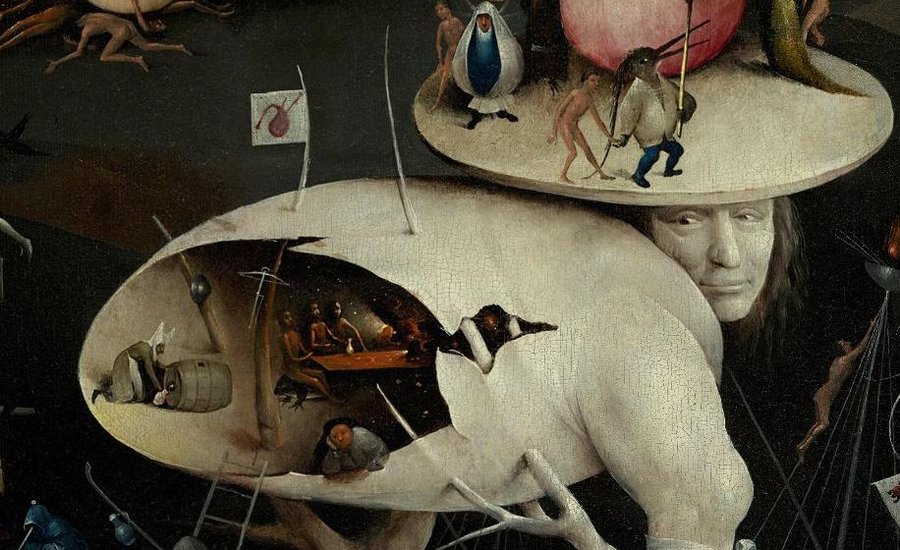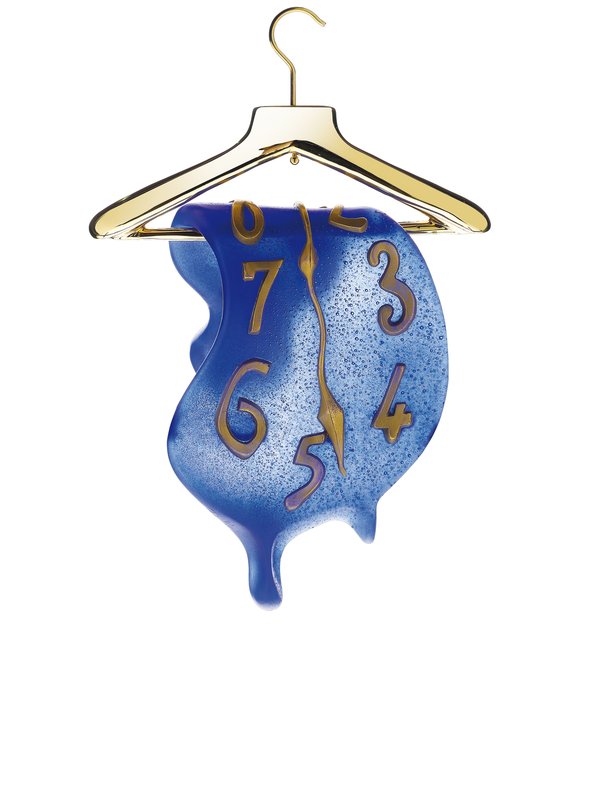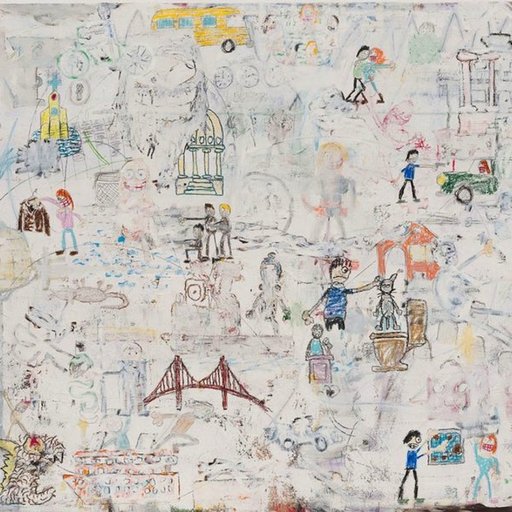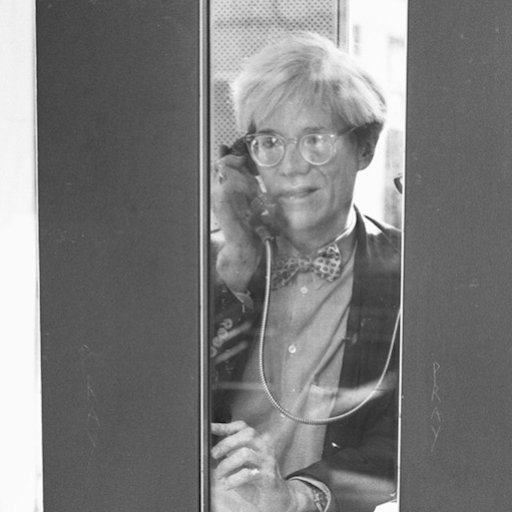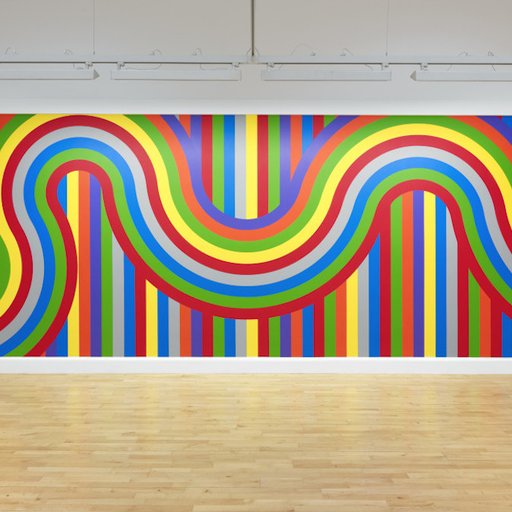If you believe in Hell, the image you have of it is probably from a Hieronymous Bosch painting.
The deeply religious 16th-century Netherlandish master painted many easy-on-the-eye artworks—biblical scenes the Wedding at Cana andThe Adoration of the Magi among them—but is best known for the stunningly detailed and imaginative nightmares he created to illustrate the consequences of sin.
With a style that influenced and presaged Salvador Dalí, M.C. Escher, Edvard Munch, René Magritte, and Pablo Picasso’s Guernica centuries later, he painted scenes that depicted fantastical horrors: naked humans surrounded by monstrous carnivorous birds, disembodied heads, grinning razor-teeth ghouls, all inflicting a variety of horrific punishments with macabre delight.
Who was Bosch and why did he have such dark thoughts?
A contemporary of Henry VII, for the Shakespeareans among you, Hieronymus Bosch was born Jheronimus (or Jeroen) van Aken outside of in an area that is now the Netherlands, circa 1450. His grandfather, father, and brothers were painters, so, perhaps to set himself apart, he took his last name from his home town of Hertogenbosch. The artist signed some works but dated very few, making historical research somewhat difficult.
What little is known about him is that he taught Pieter Breughel the Elder, was reasonably successful and reknown in his lifetime and was active in a sect of the Catholic faith. That said, he tended to be very skeptical of authority figures, from kings to clerics to the medical profession.
Only about 25 paintings and eight drawings are confidently attributed to Bosch. (Another dozen or so paintings are in dispute, and could be by his workshop or disciples.) But that small body of work is memorable.
This summer, the 500th anniversary of his death, Spain’s Prado salutes the groundbreaking genius with a retrospective "Bosch: The Centenary Exhibition," running through September 11. It proves that, long before Quentin Tarantino coined the phrase in Pulp Fiction, Bosch was “getting medieval on your ass.”
With a little art history thrown in, here, counting down to the (arguably) most unpleasant, are the top 10 ways to die, or wish you would already, in a Hieronymous Bosch painting.
10. Unanesthethzed Brain Surgery
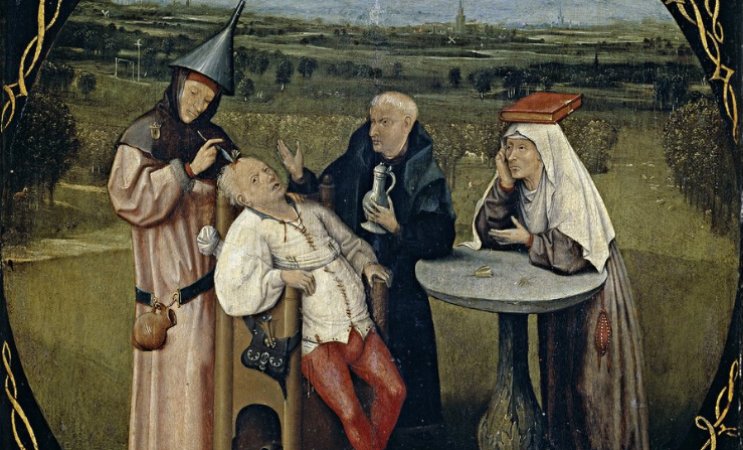 Detail from The Extraction of the Stone of Madness or The Cure of Folly
Detail from The Extraction of the Stone of Madness or The Cure of Folly
In this painting, a surgeon is removing the “stupid stone” from inside a man’s head. Removal of a cranial rock, according to Dutch folklore, was supposed to improve reasoning. Called The Extraction of the Stone of Madness or The Cure of Folly, text above the image reads partly, and disturbingly, in Flemish: “Master, cut the stone out quickly.”
While there's no proof such a surgery was performed in the era—and the painting is widely seen as making fun of blind faith in medicine—brain surgery was not unheard of in the period, and the surgeon is using the type of instrument that would have been used.
Interesting footnote: The painting was immortalized in Foucault's The History of Madness.
9. Water-Boarded With Liquor
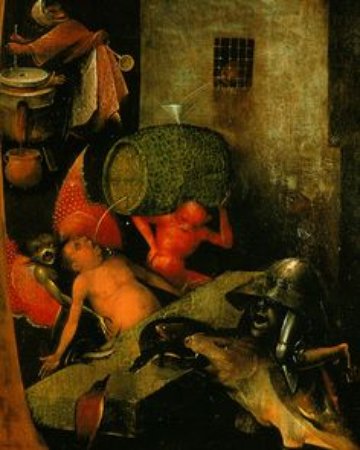 Cautionary detail from The Last Judgment
Cautionary detail from The Last Judgment
It's ironic that Bosch disdained Earthly pleasures—or at least painted as if he did—because he married quite wealthy. His wife's fortune gave him of level of descretion in what to paint and for whom, and he favored the topic of divine retribution.
No surprise, then, the Bosch triptych titled The Last Judgment, painted circa-1500, is rich in a sickening array of ways to perish. Among them is drinking to death, and in this detail from the painting giant demons restrain a glutton as they pour liquor (along with some more foul liquid, the painting implies) never-endingly down his throat.
For some people this is torture. For others, Saturday night.
8. Being Sneezed on Throughout Infinity
 Detail from Tondal's Vision
Detail from Tondal's Vision
This painting is based on a 12th-century book by an Irish monk, very widely re-published at the time (it was something of a European bestseller), that tells the tale of a knight who falls asleep and tours the afterlife. As a result of what Tondal, also called Tnugdali, has seen, he resolves to live a more spiritual life.
Bosch's Tondal's Vision features a soup of naked people; they sit in some primordial cesspool while a man with a giant nose sneezes on them. Highly unpleasant to be sure, but it's a picnic compared to what the painter has in store for others.
7. Serving as the Travel Luggage of the Damned
 Platypus-billed creatures haunt the afterlife in Bosch's art
Platypus-billed creatures haunt the afterlife in Bosch's art
Here, in the bottom third of Judgment's frame, is an instance in which the subject probably wished he was dead. Carted about by a goblin and pierced with arrows, this fellow also gets to enjoy (everlasting?) upside-down eye contact with a mutated peasant.
In Bosch's symbology, arrows are considered by some scholars to be evidence of succumbing to incorrect religious teachings. Although religious himself, Bosch sometimes depicted nuns and priests as liars—or livestock.
Interestingly, this Bosch painting became so well-known and popular that Lucas Cranach the Elder painted a version of it later in the 16th century.
6. Flayed to Ribbons by Harp Strings
 Bosch's bizarre take on popular music of his time
Bosch's bizarre take on popular music of his time
Bosch's undisputed masterpiece, The Garden of Earthly Delights, which may have taken over a decade to finish, is neary 13 feet across. Each corner is packed with details. A small section of the right panel crams in several unfortunate souls, plus a hurdy-gurdy.
Bosch was highly critical of leisure pursuits, gambling in particular, and in one notable image, a man is doomed to spend eternity rolling dice out of his mouth while being attacked by giant insects. But the artist also looked down on more prosaic pastimes, the playing and enjoyment of non-liturgical music among them.
Here, in a tiny tableau featuring musical instruments, a man is trapped, and sliced, by a giant harp while another has his flesh branded with a musical score by arguably the weirdest creature in any of Bosch's paintings. And that's saying a lot.
5. Hooray. You're Dragon Food
 Having it both ways: By claiming his interest was Heaven, Bosch was able to paint horror, as Hell
Having it both ways: By claiming his interest was Heaven, Bosch was able to paint horror, as Hell
Bosch's paintings are full of mythological creatures, both ones of his own invention and standards of fiction—dragons, harpies, arachnae. Such beings would not usually have a place in religious art, but Bosch got around that problem neatly by making his horror paintings cautionary moral tales. (Think Stephen King as a fire-and-brimstone minister.) He also presented some of the images in triptychs, a painting form associated with churches.
4. Boiled and Roasted
 Detail from The Seven Deadly Sins and Four Issues, in the collection of the Prado
Detail from The Seven Deadly Sins and Four Issues, in the collection of the Prado
One of the earliest major works believed by some to be by Bosch, this wooden table (with its tableau arranged in the shape of an eye that stares accusingly at the viewer) depicts the seven deadly sins—wrath, envy, avarice, lust, gluttony, pride, and sloth. A corner image then depicts the resulting punishment in hell. Though each is awful in its own—the proud woman has her abdomen munched on by a lizard as she watches herself in a mirror—perhaps the worst fate is reserved for the greedy. They are boiled in a golden cauldron and roasted on spits.
Interestingly, the Bosch Conservation and Research Project questions the authenticity of this piece, but the Prado, which owns it, stands by its authorship. Let's hope there's no eternal punishment for misattribution.
3. Perforated and (Cough) Penetrated
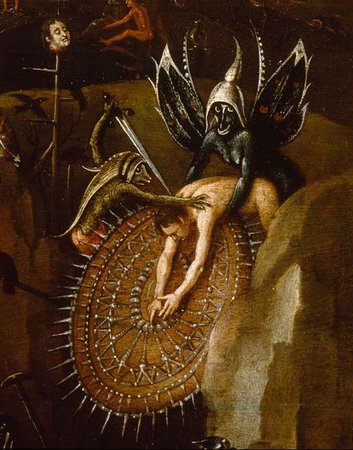
Here, a sinner is bent over a spiked metal wheel and pushed into the blades by horrific but efficient creatures who seem to be enjoying themselves immensely. The black-winged ghoul may be even be indulging in non-consensual sex. Nearby, a decapitated head "looks" on sightlessly
Daniel McDermon, writing in the New York Times, noted of Bosch paintings that, "hell's concierge service seems excellent, with an enviable demon-to-damned ratio."
2. Beaten on a Razor's Edge
 Household objects become images of torture in Bosch images
Household objects become images of torture in Bosch images
His apocalyptic visions earned the artist the nickname of "The Devil's Painter," but blood is surprisingly rare in Bosch paintings. In this gruesome image, however the fate of one sinner is to be beaten and slice on the edge of a giant knife, encircled by a buffet of severed body parts.
Household and everyday objects are common in the artist's work, from wheels to bells to funnels to mirrors. Card tables and backgammon boards also appear frequently, especially in hell, but prosaic objects are usually perverted to evil means.
1. The Worst?

The Garden of Earthly Delights is also in the collection of the Prado. (It, and other Bosches, were brought to the museum by King Philip II of Spain, who was a fan.) The first two panels depict Eden and Earth, but the third is a seething vision of hell.
It is one of Bosch's more creative pieces in terms of the various manners of death, but this painful and scatalogical one is perhaps the worst way to go: chomped on by a giant bird and expelled into a Hellmouth, awake, as waste, while birds fly out of body cavities and others void themselves in the crowded cloaca of the damned below.
Coda: As a result of researching this story, we have resolved to lead a more spiritual life.
RELATED ARTICLES:
What Was Surrealism? Read the Real Story Behind the Enigmatic Art Movement











